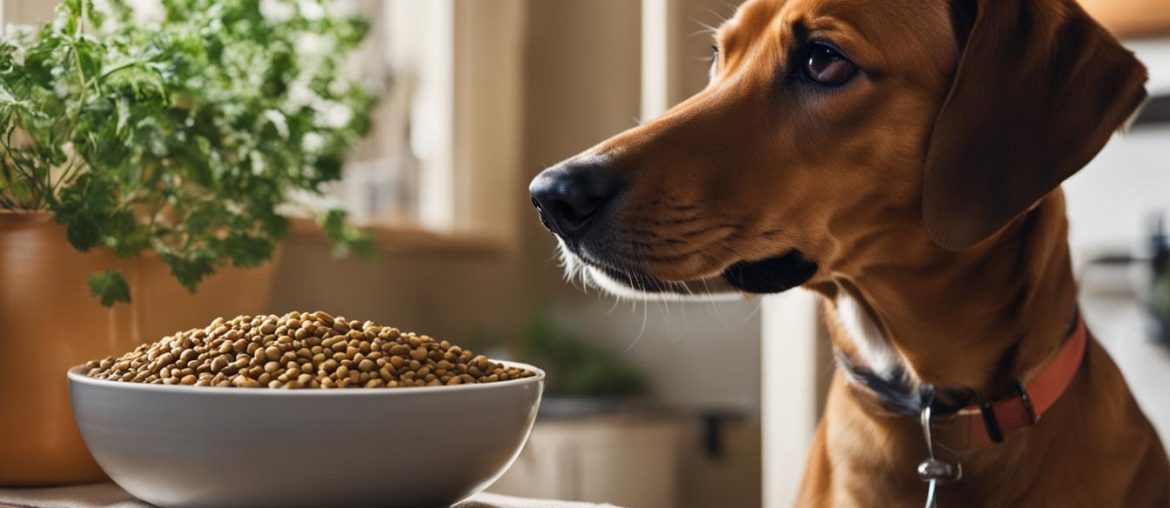As a dog owner, you want to ensure that your furry companion is getting the best nutrition possible. You may have heard about the benefits of lentils and wondered if they are safe for dogs to eat. In this guide, I will provide you with all the information you need to know about feeding lentils to your beloved pet.
Lentils are a nutritious food for dogs, packed with essential nutrients such as fiber, protein, B vitamins, phosphorus, iron, zinc, and carotenoids. They offer numerous health benefits, including weight management and a reduced risk of heart disease. However, it’s important to understand the potential risks and controversies surrounding lentils so that you can make an informed decision for your dog’s diet.
Key Takeaways:
- Lentils are a great source of nutrients for dogs, including fiber, protein, B vitamins, phosphorus, iron, zinc, and carotenoids.
- They are low in starch and high in fiber, making them suitable for diabetic dogs and helping to keep dogs feeling fuller for longer.
- Introduction of lentils to a dog’s diet should be gradual to avoid gastrointestinal issues.
- Cooking lentils thoroughly is recommended to improve digestibility and reduce the risk of stomach upset.
- While there are controversies surrounding lentils, the current evidence suggests that the benefits outweigh the potential risks.
The Nutrition of Lentils for Dogs

Lentils are a nutritious addition to a dog’s diet, providing a range of essential nutrients that contribute to good overall health. They are packed with fiber, protein, and a variety of vitamins and minerals. When prepared and served properly, lentils can be a valuable source of nutrition for dogs.
Lentils Nutritional Profile
Let’s take a closer look at the nutritional profile of lentils. They are rich in iron, folate, magnesium, potassium, phosphorus, zinc, and B vitamins. These nutrients are essential for various bodily functions and can support overall well-being in dogs. The fiber content in lentils aids in digestion and can help regulate bowel movements.
Additionally, lentils are a low-fat food and can provide dogs with energy without contributing excess calories. This makes them particularly beneficial for weight management and can help overweight dogs shed a few pounds.
Welcome Addition to a Balanced Diet
Lentils can be included as part of a well-balanced diet for dogs. However, they should not be the sole source of nutrition. Dogs require a mix of proteins, fats, and carbohydrates, along with other essential nutrients found in commercial dog food or a veterinarian-approved homemade diet.
When incorporating lentils into a dog’s diet, it’s recommended to cook them thoroughly to enhance digestibility and reduce the risk of any digestive issues. Plain, unsalted, and unseasoned cooked lentils are the best option for dogs, as added salts and seasonings can be harmful to their health.
| Nutrient | Amount per 100g |
|---|---|
| Protein | 25g |
| Fiber | 8g |
| Iron | 3.3mg |
| Phosphorus | 451mg |
| Potassium | 745mg |
| Zinc | 3.6mg |
| Vitamin B6 | 0.3mg |
It’s always best to consult with a veterinarian before making any significant changes to your dog’s diet. They can provide personalized advice based on your dog’s individual needs, taking into account factors such as age, breed, and any existing health conditions. With the right approach, lentils can be a healthy and nutritious addition to your dog’s meal plan.
Lentils and Dogs’ Digestion

When considering adding lentils to your dog’s diet, it is important to understand how lentils can affect their digestion. Lentils have a slower digestion rate compared to other starch sources, which means that consuming too many lentils at once can result in gastrointestinal issues such as diarrhea or constipation.
Introducing lentils gradually into your dog’s diet and observing their reaction is crucial. This allows their digestive system to adapt to the new food and reduces the risk of stomach upset. Additionally, cooking lentils thoroughly can improve their digestibility and make them easier for your dog to process.
It is recommended to serve plain, unsalted, cooked lentils to your dog. Avoid lentil soups or dishes that may contain ingredients like garlic or onion, as these can be toxic to dogs. By taking these precautions and monitoring your dog’s response, you can incorporate lentils into their diet safely and promote healthy digestion.
The Benefits of Lentils for Dogs

Lentils offer a variety of benefits for dogs, making them a valuable addition to their diet. Here are some of the key advantages of incorporating lentils into your furry friend’s meals:
- Nutrient-rich: Lentils are packed with essential nutrients like fiber, protein, B vitamins, phosphorus, iron, zinc, and carotenoids. These nutrients contribute to overall health, support digestion, and provide energy for your dog.
- Weight management: Lentils are low in fat and high in fiber, which can help dogs feel fuller for longer and assist with weight management. They are a nutritious option to include in a balanced diet for dogs that need to shed a few pounds.
- Cholesterol reduction: The soluble fiber found in lentils can help lower cholesterol levels in dogs. Incorporating lentils into their diet can contribute to maintaining a healthy heart and cardiovascular system.
- Diabetic support: Lentils have a low glycemic index and are rich in fiber, making them suitable for diabetic dogs. They can help regulate blood sugar levels and provide a slow release of carbohydrates, preventing spikes in glucose levels.
- Allergy-friendly: Lentils are an excellent option for dogs with food allergies or sensitivities. They offer a nutritious alternative to common allergenic ingredients, such as wheat, corn, or soy.
When serving lentils to your dog, it is essential to cook them thoroughly to improve digestibility and break down potentially harmful lectins. Remember to avoid adding any seasonings, salts, or ingredients like garlic or onion that can be toxic to dogs. Feeding plain, unsalted, cooked lentils in moderation is the best way to reap the benefits they offer.
Incorporating lentils into your dog’s diet can have numerous advantages, from supporting weight management to providing essential nutrients and promoting a healthy heart. However, every dog is unique, and consulting with a veterinarian is always recommended before making any significant changes to their diet. They can offer personalized advice based on your dog’s specific needs and health condition.
Lectins in Lentils for Dogs
When considering adding lentils to your dog’s diet, it’s important to understand the potential risks associated with lectins. Lectins are proteins found in lentils and other legumes that can cause gastrointestinal issues and toxicity in large quantities. However, the good news is that cooking lentils can break down these lectins and make them safe for dogs to consume.
Cooking methods such as boiling or steaming lentils are recommended to reduce the lectin content effectively. It’s crucial to avoid feeding raw lentils to dogs, as raw legumes, including lentils, can be toxic and difficult to digest. By thoroughly cooking lentils, you can ensure that your dog can safely enjoy the nutritional benefits without the risks associated with lectins.
| Lentil Preparation | Lectin Content |
|---|---|
| Raw Lentils | High |
| Cooked Lentils | Low |
In summary, lectins in lentils can be problematic for dogs when consumed in large amounts or in their raw state. However, through proper cooking methods, you can significantly reduce the lectin content and ensure the safety of your furry friend. Always remember to consult with your veterinarian before making any dietary changes to meet your dog’s specific needs.
Lentils and the DCM Heart Condition in Dogs

There has been ongoing discussion about the potential link between lentils and the development of dilated cardiomyopathy (DCM) in dogs. Although the association exists, it is essential to note that the evidence is still limited, and further research is needed to establish a definitive connection. The U.S. Food and Drug Administration (FDA) is actively investigating this matter to determine the extent of the potential risks.
It’s crucial to remember that DCM is a complex condition influenced by various factors, including genetics and breed predisposition. While certain legumes, including lentils, have been implicated, it is essential to consider the overall diet and individual dog’s health status. Consulting with a veterinarian is highly recommended, particularly if your dog is at risk for or has been diagnosed with DCM.
“The potential association between lentils and DCM highlights the importance of a balanced and individualized approach to dog nutrition. While lentils offer nutritional benefits, it’s crucial to consider the overall diet and any underlying health conditions.” – Dr. Amanda Rodriguez, DVM
Table: Summary of Lentils and the DCM Heart Condition in Dogs
| Key Points | Details |
|---|---|
| Potential Link | An association has been observed between certain legumes, including lentils, and the development of DCM in dogs. |
| Evidence | The evidence is limited, and further research is necessary to establish a definitive connection. |
| Complex Condition | DCM is a multifactorial condition influenced by genetics, breed, and overall diet. Lentils are just one consideration. |
| Consultation | Consult with a veterinarian, especially if your dog is at risk for or has been diagnosed with DCM. |
While the potential link between lentils and DCM is a topic of concern, it’s important to remember that the risks are not yet fully understood. Lentils can still be a part of a balanced and nutritious diet for dogs, provided they are cooked properly and served in moderation. As with any dietary changes, it is always best to seek professional guidance and monitor your dog’s health closely.
Possible Side Effects of Feeding Dogs Lentils

While lentils can be a beneficial addition to a dog’s diet, there are some potential side effects to be aware of. Feeding dogs lentils, especially in large quantities or without proper preparation, can sometimes lead to gas, stomach upset, or gastrointestinal issues. It is important to introduce lentils gradually into a dog’s diet and monitor their reaction. If your dog experiences any digestive discomfort, it may be necessary to reduce or eliminate lentils from their meals. Additionally, lentils purchased from stores may contain added salts and seasonings, which can be harmful to dogs. It is crucial to feed plain, unsalted, cooked lentils to dogs and avoid lentil soups or dishes that may contain ingredients like garlic or onion, which are toxic to dogs.
One way to mitigate the potential side effects of feeding dogs lentils is to cook them thoroughly. Properly cooked lentils are easier to digest and have reduced lectin content. Boiling or steaming lentils is recommended to ensure they are safe for dogs to eat. Avoid feeding raw lentils to dogs, as raw legumes, including lentils, can be toxic and difficult to digest.
As with any dietary changes, it is essential to observe your dog’s individual response and consult with a veterinarian. They can provide personalized advice based on your dog’s specific needs and circumstances. By taking the necessary precautions and monitoring your dog’s well-being, you can safely incorporate lentils into their diet and provide them with the benefits of this nutritious legume.
Lentils in Moderation
While lentils offer several benefits and can be a valuable addition to a dog’s diet, it is important to remember that moderation is key. Feeding excessive amounts of lentils or making them a staple in your dog’s meals can lead to digestive issues and potentially unbalance their overall diet. Lentils should serve as a supplement to a well-balanced and complete canine diet, rather than a primary source of nutrition. When feeding lentils to your dog, it is crucial to ensure they receive a varied diet that includes other essential nutrients found in meat, vegetables, and appropriate dog food. Strive for balance and consult with your veterinarian to determine the appropriate portion size and frequency of lentil consumption for your dog.
How to Cook and Serve Lentils to Dogs
When it comes to cooking and serving lentils to dogs, simplicity is key. Follow these easy steps to ensure your furry friend can enjoy the nutritional benefits of lentils in a safe and healthy way.
Step 1: Choose the Right Lentils
Start by selecting the right type of lentils for your dog. Green, brown, and red lentils are commonly available and suitable for dogs. Make sure to purchase plain, unseasoned lentils without any added salt or flavorings.
Step 2: Thoroughly Cook the Lentils
Cooking lentils is simple and can be done by boiling them according to the instructions on the package. It’s important to cook lentils until they are soft and fully cooked to enhance digestibility and break down any potentially harmful lectins. Avoid using any oils, spices, or seasonings while cooking lentils for your dog.
Step 3: Serve in Moderation
When serving lentils to your dog, remember that moderation is key. Lentils should not make up the majority of their diet. Instead, consider using lentils as an occasional addition to their regular meals. Start by introducing lentils in small amounts and observe your dog’s reaction. If they tolerate lentils well, you can gradually increase the portion size.
By following these simple steps, you can provide your dog with a wholesome and nutritious lentil meal. Just remember to cook the lentils thoroughly, avoid any additives, and serve in moderation to ensure your dog can safely enjoy the benefits of lentils.
Wrapping Up
After considering the benefits and potential risks, it is clear that lentils can be a valuable addition to a dog’s diet when served in moderation and prepared correctly. Lentils provide essential nutrients, including fiber, protein, and a variety of vitamins and minerals that contribute to good overall health. They can help with weight management, cholesterol reduction, and even support diabetic dogs due to their low sugar content and high fiber content.
While there are controversies surrounding lentils, such as the presence of lectins and the association with the DCM heart condition, the current evidence suggests that the benefits of lentils outweigh the potential risks. Cooking lentils thoroughly and avoiding the feeding of raw lentils can help reduce any potential issues due to lectins. Additionally, it is recommended to consult with a veterinarian, especially if your dog is at risk for or has been diagnosed with DCM, for personalized advice on feeding lentils.
Remember to introduce lentils gradually into your dog’s diet and observe their reaction. Be mindful of the serving size and avoid lentils with added salts and seasonings that may be harmful to dogs. By following these guidelines and seeking professional advice, you can safely incorporate lentils into your dog’s meal rotation, offering them a nutritious and varied diet.
FAQ
Can dogs eat lentils?
Yes, dogs can eat lentils. Lentils are a great source of nutrients for dogs, including fiber, protein, B vitamins, phosphorus, iron, zinc, and carotenoids.
What are the benefits of lentils for dogs?
Lentils offer several benefits for dogs, including weight management, cholesterol reduction, and providing a low-cost source of fiber and protein. They may also be beneficial for diabetic dogs and those with food allergies or sensitivities.
Are lentils safe for diabetic dogs?
Yes, lentils are suitable for diabetic dogs due to their low sugar content and high fiber content, which can help regulate blood sugar levels.
Can lentils cause gastrointestinal issues in dogs?
Yes, consuming too many lentils or introducing them too quickly into a dog’s diet can result in gastrointestinal issues like diarrhea or constipation. It is important to introduce lentils gradually and cook them thoroughly to improve digestibility.
Do lentils contain lectins?
Yes, lentils contain lectins, which are potentially problematic proteins. However, cooking lentils thoroughly can break down these lectins and make them safe for dogs to eat.
Are lentils linked to the development of dilated cardiomyopathy (DCM) in dogs?
There has been some association between legumes, including lentils, and the development of DCM in dogs. However, the evidence is limited, and the FDA is still investigating this link. It is recommended to consult with a veterinarian for guidance on feeding lentils to dogs, especially if they are at risk for or have been diagnosed with DCM.
What are the possible side effects of feeding dogs lentils?
Feeding dogs lentils can sometimes lead to gas, stomach upset, or gastrointestinal issues, especially if introduced too quickly or in large quantities. Lentils purchased from stores may also contain added salts and seasonings, which can be harmful to dogs.
How should I cook and serve lentils to dogs?
Lentils should be cooked thoroughly without adding any additional flavorings or seasonings. Boiling or steaming lentils is recommended to reduce lectin content and improve digestibility. It is important to feed plain, unsalted, cooked lentils to dogs.
Can I feed lentil soups to my dog?
It is best to avoid lentil soups that may contain ingredients like garlic or onion, which are toxic to dogs. Stick to plain, unsalted, cooked lentils for your dog.






